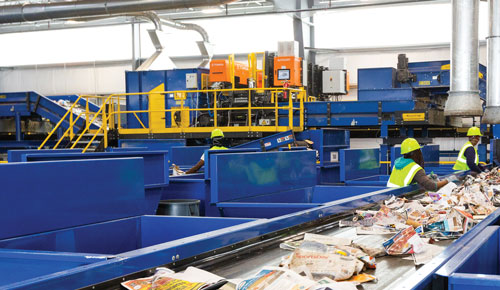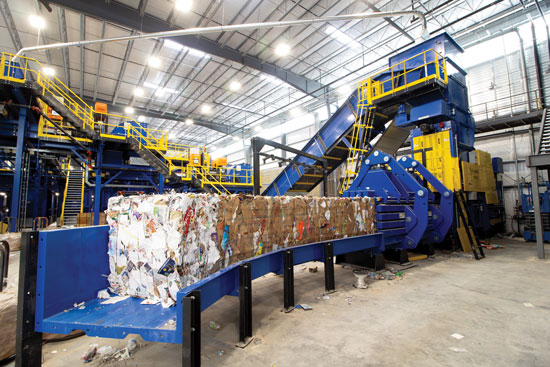With contamination rates on the rise, positive sorting with optical sorters is becoming the most reliable way to make sellable end products and create an MRF that is flexible enough to evolve with the future.
By Mark Neitzey
No two residential single stream MRFs in North America are the same. This has become abundantly clear to us as MRF designers over the past few decades. Some states have bottle bills, some programs do not accept glass, some communities have poor public awareness of what belongs in the recycling bin, and highly represented demographics have tendencies to consume certain types of material (MRFs in younger communities will not see newspapers nearly as often as Amazon envelopes and boxes). Even weather conditions can change the composition of an MRF’s incoming material. Events like a pandemic create sudden impact: inundating MRFs with cardboard and restaurant to-go containers.
However, there is one thing that all of these MRFs can benefit from: having a reliable strategy for creating sellable end products in the face of high contamination. In recent years we have been
designing MRFs and retrofits that incorporate principles of positive sorting at various stages. Positive sorting lays the groundwork for an MRF to be able to quickly adapt its sorting strategies based on composition changes in their incoming material as well as changes in market value for particular end products. So, what is positive sorting?
Positive and Negative Sorting
Positive sorting is recognizing, selecting and ejecting a desired product (and only that product) from the rest of the stream. This can only be done by intelligent separation devices, sorting equipment such as optical sorters, robots or even human sorters. These sorters have the “intelligence” (of either the human brain, NIR scanning or camera recognition) to recognize desired items by shape, color or specific material composition. To understand how positive sorting is applied in an MRF setting, you merely have to think about the most common positively sorted material at any MRF: PET bottles. The vast majority of MRFs in North America have a dedicated optical sorter to positively eject PET from the rest of the container stream (which passes through as the negatively sorted stream). However, the vast majority of these MRFs do not apply the same strategy to desired materials on their fiber line. Instead, they rely on traditional principles of mechanical separation that attempt to remove cardboard, containers, film, organics and trash, and hope that what is left is a negatively sorted stream of clean paper. But that is rarely the case.

Most MRFs still have primary fiber screens with coarse spacing to separate fiber from containers using sizing and screen angles. Light, flat materials (theoretically paper) pass over the screen and 3D materials (theoretically plastic and aluminum containers) fall back and under the screen. Many have upgraded to a non-wrapping style screen to minimize film bags wrapping and some use ballistic separators to perform this separation, but the principal has not changed. They are still using non-intelligent machines to separate a complex material stream. These screens and ballistics have no way to tell the difference between paper, film plastic and a flattened PET bottle. They cannot distinguish between a milk jug and a small, 3D cardboard box. They carry over anything that is lightweight and flat, and anything that is 3-dimensional will bounce off.
The 2D fraction that carries over these machines falls onto a quality control conveyor for final inspection, where outthrows and prohibitive materials (think film, flat PET, flat aluminum) are positively removed before the remaining fiber (or what is hoped to be fiber) is dropped off the end of the sort belt as the negative sort into a pile for baling. This strategy negatively sorts on the desired material and positively sorts on everything else. Because the “everything else” category is so varied and includes items such as black plastic that can only be seen with specialized software, it is difficult to get anywhere close to 100 percent purity with negative sorting.
Let’s say you are trying to make a mixed paper grade. If your inbound stream is contaminated with a high percentage of film or trash, the numbers do not make sense for the negative sorting of paper as described above. If your fiber QC line (what carried over those mechanical screens) is moving at a rate of 5 tons/hour, with 8 to 10 percent prohibitives in it, that could mean you need 1,000 picks per minute of prohibitives to end up with a negative sort of clean paper. If you assembled a dream team of the four best QC sorters in the world and paired them with the four sexiest robots, and they all averaged 60 picks per minute, they might be able to sort out 500 prohibitive items per minute. The remaining material (the negative sort) that falls into the bunker would still not make the ISRI specification for prohibitives.
Now, not every MRF has the budget or the space to overhaul their system or essentially start from scratch with a fully positive sorting design. Here are three ways to employ positive sorting in your operation that are achievable for any MRF, regardless of size or capacity.

Photos courtesy of Van Dyk Recycling Solutions.
#1: Positive Sorting of Mixed Paper
If you are blending your fiber fractions off of three angled screens into one mixed paper grade, make sure you are positively sorting that last stream of fiber that comes off that last screen. We have seen that 80 percent of contamination in mixed paper grades with this setup comes from this last bit of material. If you place an optical sorter on this line to positively eject all fiber (regardless of size or shape) from the remaining mix of bottles, cans, film, organics, wood, metals, wet materials, etc., you can successfully blend that bit of fiber back into the larger fractions of fiber without compromising the whole lot.
#2: Positive Sorting of All Paper from Film and Browns if Your Stream has a High Percentage of Either
Does your stream have a high percentage of film? Film is going to masquerade as paper and end up in the fiber line. Why spend effort trying to remove all that film from your paper and risk not getting clean paper anyway? Reverse the logic: an optical sorter can shoot on paper and positively eject it from the film, guaranteeing a clean paper product. If your stream has a high percentage of small OCC, then you have a few opportunities. You can positively sort on white paper, ejecting it out and sending it to its own QC line to make an SOP grade. Or you can positively sort browns from that stream and send it to be blended with your OCC bales or on its own QC line as a “hard pack.” With positive sorting, you will have the flexibility to flip between any of those options when you see composition changes in your incoming stream.
#3: Positive Sorting of All Fiber Out of a Container Stream Prior to the Commingled Line
Due to the popularity of online ordering rising over the last decade and skyrocketing during the pandemic, MRFs have become overrun with OCC, in particular, small 3-dimensional OCC and boxboard. These 3-dimensional boxes can act like containers, end up in your container line and, ultimately, land in the residue pile if you do not have a last chance mechanism in place. Mechanical screens and ballistic separators are reliable methods of separating 2D paper from 3D containers, but they cannot tell the difference between a balled-up Amazon box and a milk jug. To a screen, they are both 3D items that are bouncing back and heading to the container line. Adding an optical sorter immediately prior to a container line and shooting positively on fiber can prevent those fiber items from going forward and mucking up the container sort. And you can have the flexibility to positively eject all fiber back to the fiber line or just eject brown fiber to the OCC QC line.
With contamination rates on the rise, positive sorting with optical sorters is becoming the most reliable way to make sellable end products and create a MRF that is flexible enough to evolve with the future. | WA
Mark Neitzey is Director of Sales for Van Dyk Recycling Solutions (Norwalk, CT). For more information on positive sorting principles, call (203) 967-1100 or e-mail [email protected].
